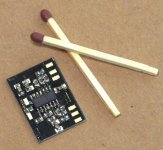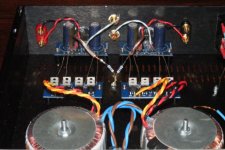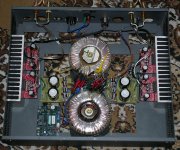john blackburn said:RobertJ88
I'm 47 and I've just finished my first amp, it's nowhere near as good as yours, beautiful work by any measure.
John
I agree, I am twice your age and my build is nowhere close to that!... very solid.
If I may add, something I saw in te NASA photoguidelines I posted before. That braided sleeving... the ends should idealy be rolled back inside the tube... preventing it from fraying...and also providing protection from cable tie stresses...
tubee said:Nice amp Robert!!
1 suggestion: try to get proper solid copper rails instead of the aluminium ones.
Good one! Soon I will start making some drawings.
I really like the shine of polished copper.
I didn't know that technique, thanks for the tip.Nordic said:If I may add, something I saw in te NASA photoguidelines I posted before. That braided sleeving... the ends should idealy be rolled back inside the tube... preventing it from fraying...and also providing protection from cable tie stresses...
Usually I melt the endings of the sleeving, en finish it with some heat shrink...
offtopic
*searching for a old cable*
Found something, this one isn't neat, but you get the point...

clickable
/offtopic
Thanks for all the compliments!

I have finally finished my Peter Daniels LM3875 Premium kit. It is a dual mono setup, with a passive pre (pot in a box type). I had a few minor issues with ground hum, but I sorted it with heavy duty ground cables and 10 Ohm ground lift resistors on each channel.
My total spend on the Gainclone and Pre was around the £150 mark, and well worth every penny. I could have spent more by using more expensive components, i.e Black gates in the PSU rails (not everyones cup of tea) or a more expensive case, but on balance I think I got the mix right. Sound for pound/bang for buck, the Gainclone has to be up there with the best.
The cases are from hifi2000.com (Italy) and the transformers are 18V/120VA from RS Components (UK). I used an Alps Blue 50K dual log pot for the volume control (HiFi Collective)
My review,
Kit, Lightly modded NAD C520 (Schotky diodes, Black gates in output, Muting transistors removed, NE5532 Op Amps replaced with LM4562NA Chips), NeoTech/Puresonic IC's, Wharfedale Diamond 8.3's with IXOS Bi Wire cables, Olson mains conditioning block. Test track's, Leftfield - Phat Plannet, Dark Side of the Moon - Speak to Me/Breathe/On the Run/Great Gig in the Sky, Led Zeppelin - Kashmir/Over the Hills and Far Away, Holst - The Plannets (Mars).
This Gainclone produces an open and detailed sound. The timing is precise, with no mushyness in the top end. Cymbals and snare drums are faithfully reproduced and vocals are clear and precise. Mid's and high's are especially open and detailed. Bass is a little lean, but well presented and controlled. IMO
I am more than happy with the amp. For a first attempt at DIY, I am blown away with what is possible for just a small outlay.
My total spend on the Gainclone and Pre was around the £150 mark, and well worth every penny. I could have spent more by using more expensive components, i.e Black gates in the PSU rails (not everyones cup of tea) or a more expensive case, but on balance I think I got the mix right. Sound for pound/bang for buck, the Gainclone has to be up there with the best.
The cases are from hifi2000.com (Italy) and the transformers are 18V/120VA from RS Components (UK). I used an Alps Blue 50K dual log pot for the volume control (HiFi Collective)
My review,
Kit, Lightly modded NAD C520 (Schotky diodes, Black gates in output, Muting transistors removed, NE5532 Op Amps replaced with LM4562NA Chips), NeoTech/Puresonic IC's, Wharfedale Diamond 8.3's with IXOS Bi Wire cables, Olson mains conditioning block. Test track's, Leftfield - Phat Plannet, Dark Side of the Moon - Speak to Me/Breathe/On the Run/Great Gig in the Sky, Led Zeppelin - Kashmir/Over the Hills and Far Away, Holst - The Plannets (Mars).
This Gainclone produces an open and detailed sound. The timing is precise, with no mushyness in the top end. Cymbals and snare drums are faithfully reproduced and vocals are clear and precise. Mid's and high's are especially open and detailed. Bass is a little lean, but well presented and controlled. IMO
I am more than happy with the amp. For a first attempt at DIY, I am blown away with what is possible for just a small outlay.
Attachments
I can't seem to post more than one pic at a time so here is my last picture.
You can see the ground lift resistors in the middle of the picure. Also, on the R/H transformer you can just about see the extra winding for the blue LED on the fromt panel (18 turns of insulated copper wire, directly soldered to the LED).
You can see the ground lift resistors in the middle of the picure. Also, on the R/H transformer you can just about see the extra winding for the blue LED on the fromt panel (18 turns of insulated copper wire, directly soldered to the LED).
Attachments
Peter Daniels LM3875 Dual Mono Classic Kit.
300VA torroid with 2x21 on the secondaries.
Built to my lancetta's with a sensitivity of only 80 dB/2,83 V.
My first intention was to run the speakers with my sonic t-amp but not surprisingly the load was to heavy. Bass was close to zero and midrange was hissing ugly .
The gainclone sounds great! I have read that gainclones doesnt come along with heavy load speakers but mine seems to do the job just fine. Could need som more bass though. If I "cheat" and use an equalizer (i use my laptop as source) the chipamp delivers bass the way i like it but it doesnt seems right to shape the signal before i send it to the gainclone...
Maybe a big buffer will help.
The case is oak and aluminium.
I have left som space in the front for a volume pot and maybe some other bling bling.
Back
300VA torroid with 2x21 on the secondaries.
Built to my lancetta's with a sensitivity of only 80 dB/2,83 V.
My first intention was to run the speakers with my sonic t-amp but not surprisingly the load was to heavy. Bass was close to zero and midrange was hissing ugly .
The gainclone sounds great! I have read that gainclones doesnt come along with heavy load speakers but mine seems to do the job just fine. Could need som more bass though. If I "cheat" and use an equalizer (i use my laptop as source) the chipamp delivers bass the way i like it but it doesnt seems right to shape the signal before i send it to the gainclone...
Maybe a big buffer will help.
The case is oak and aluminium.
An externally hosted image should be here but it was not working when we last tested it.
I have left som space in the front for a volume pot and maybe some other bling bling.
An externally hosted image should be here but it was not working when we last tested it.
Back
An externally hosted image should be here but it was not working when we last tested it.
An externally hosted image should be here but it was not working when we last tested it.
h@kan -
Very nice indeed - beauty in simplicity.
I keep toying with the Lancetta idea but not an easy build. What drivers are you using- surprised at low sensitivity?
Bluto
Very nice indeed - beauty in simplicity.
I keep toying with the Lancetta idea but not an easy build. What drivers are you using- surprised at low sensitivity?
Bluto
recased mine as i could never find a nice piece of wood for the lid/sides.


used 3 ABS boxes from maplin and repainted them with some plast X texture paint.........a bit grubby but thats because its been drying in the shed all night.....


used 3 ABS boxes from maplin and repainted them with some plast X texture paint.........a bit grubby but thats because its been drying in the shed all night.....
i really like the finish on those maplin boxes. very innovative and unique.
how did you make your amp "float" above your power supplies?
how did you make your amp "float" above your power supplies?
thanks guy, theres some chrome tubing (i found it knocking around, think it was a table leg or something 😀, its not quite finished as the base is not connected to the bottom, but i'll make sure i get some pics when it is done.
- Home
- Amplifiers
- Chip Amps
- Chip Amp Photo Gallery






